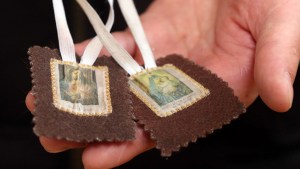Many Catholics are familiar with the Brown Scapular of Our Lady of Mount Carmel, a sacramental that is frequently given to children at the time of their First Communion.
However, not everyone is aware of the origin of the Brown Scapular devotion.
What is a scapular?
First of all, its important to explain what a scapular is and how they are connected to religious orders.
The Catholic Encyclopedia explains: “The scapular (from Latin, scapula, shoulder) forms a part, and now the most important part, of the habit of the monastic orders. It is usually worn over the habit or soutane … It consists essentially of a piece of cloth about the width of the breast from one shoulder to the other (i.e. about 14 to 18 inches), and of such a length that it reaches not quite to the feet in front and behind.”
This larger type of scapular is worn by many religious orders, such as the Carmelites, Dominicans, Benedictines and some Franciscans.
It may have originally been an apron used for work that was placed over the top of a religious habit.
Eventually the laity would be permitted to wear smaller scapulars, which are small square pieces of cloth, suspended from ribbons to hang front and back, and typically worn underneath clothing.
Where did the Brown Scapular come from?
The Brown Scapular of Our Lady of Mount Carmel is associated with the Carmelite Order, which has its roots among hermits who lived in the Holy Land.
The precise history regarding the scapular worn by Carmelites is shrouded in legend, as the Catholic Encyclopedia explains:
According to a pious tradition the Blessed Virgin appeared to St. Simon Stock at Cambridge, England, on Sunday, July 16, 1251. In answer to his appeal for help for his oppressed order, she appeared to him with a scapular in her hand and said: “Take, beloved son this scapular of thy order as a badge of my confraternity and for thee and all Carmelites a special sign of grace; whoever dies in this garment, will not suffer everlasting fire. It is the sign of salvation, a safeguard in dangers, a pledge of peace and of the covenant.”
There is some debate as to the veracity of this legend, but at the same time, “Although it has now been sufficiently shown that this testimony cannot be supported by historical documents, still its general content remains a reliable pious tradition; in other words, it is credible that St. Simon Stock was assured in a supernatural manner of the special protection of the Blessed Virgin for his whole order and for all who should wear the Carmelite habit.”
The Carmelite habit still traces its history to St. Simon Stock, and the Brown Scapular devotion likely developed around that time period.



